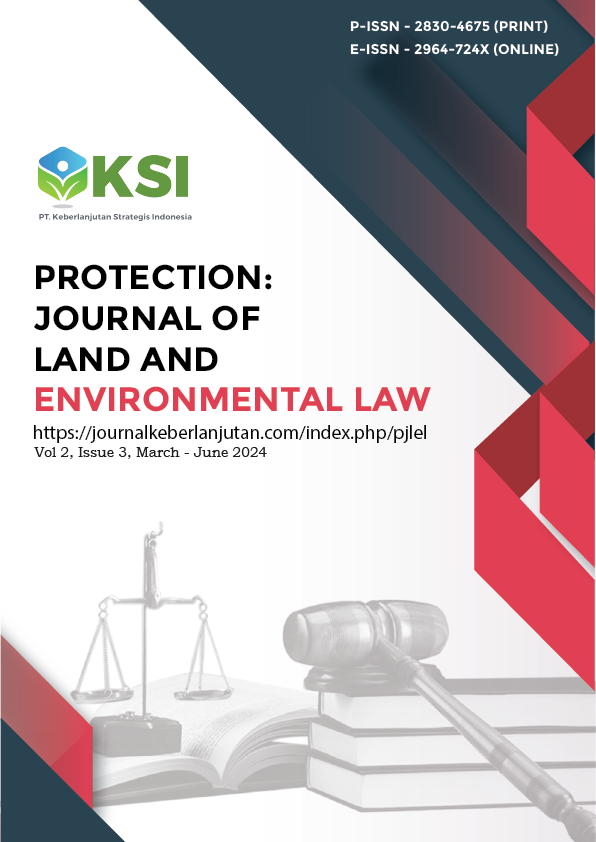The The Effect of Population Pressure on the Erosion Hazard Level of Sub-Watersheds
DOI:
https://doi.org/10.38142/pjlel.v2i3.1230Keywords:
Population Pressure, Land, Watershed, Erosion Danger LevelAbstract
The accuracy of land use and management affects the watershed's or sub-watershed's health, especially upstream. The Lesti sub-watershed in Malang Regency is the upstream part of the Brantas watershed; their land use pattern is always associated with erosion rates, which impact sedimentation in the middle and downstream. When discussing erosion, the rate increase is generally influenced by erodibility, erosivity, length/gradient of the slope, and plant factors/conservation measures. Population pressure has not been discussed much, although the erosion rate affecting sedimentation in the Sengguruh Reservoir as an outlet for the Lesti Sub-watershed has much to do with the Population's activities. People's activity and choice of land use put pressure on the land, affecting the watershed's carrying capacity. Measuring the land's carrying capacity is usually known from the value of existing population pressure and its effect on vulnerability or Erosion Hazard Level (EHL). This study attempted to assess the relationship between erosion hazard levels and population pressure and determine conservation priority areas in the Lesti sub-watershed. This research method was carried out quantitatively, which involved calculating the analysis of population pressure and the EHL obtained spatially from the erosion rate of the Modified Universal Soil Loss Equation (MUSLE) and soil solum. The results showed a similar wedge between high population pressure and severe EHL. This Area is recommended as the most priority location for conservation policies in the Lesti sub-watershed.
References
Ariani, R.D., & Harini, R. (2012). Population Pressure on Agricultural Land in Agricultural Areas (Case of Minggir and Moyudan Districts). Jurnal Bumi Indonesia, 1(3), 1-8.
Arsyad, S. (2006). Soil and Water Conservation. Bogor: IPB Press.
Asdak, C. (2010). Hydrology and Watershed Management. Fifth Edition (Revised). Yogyakarta: Gadjah Mada University Press.
Bappenas (2015). Study of the Influence of Water Resources Conservation Policy in Watersheds on the Forestry Sector and Other Sectors. Jakarta: National Development Planning Agency.
Bellfield, B., Leggett, M., Trivedi, M., Pareira, J., Gangga, A. (2016). How Can Indonesia Achieve Water, Energy and Food Security?. Jakarta: WCS and Global Canopy Programme. Chaidar, A.N., Soekarno, I., Wiyono, A., & Nugroho, J. (2017). Spatial Analysis of Erosion and Land Criticality of the Upstream Citarum Watershed. International Journal of GEOMATE, 13(77), 133-140. https://doi.org/10.21660/2017.37.34572
Common, M., & Stagl, S. (2005). Ecological Economics: An Introduction. New York: Cambridge University Press.
Cumming, G. S. (2016). The relevance and resilience of protected areas in the Anthropocene. Anthropocene, 13, 46–56. https://doi.org/10.1016/j.ancene.2016.03.003
Djajasinga, V., Masrevaniah, A., & Juwono, P. T. (2013). Economic Study of Sediment Management in Seri Reservoirs in Brantas River (Sengguruh, Sutami and Wlingi). Journal of Water Resources Engineering, 3(2), pp.143–152. Retrieved from https://jurnalpengairan.ub.ac.id/index.php/jtp/article/view/159.
Hardjowigeno S. (1995). Soil Science. Jakarta: Akademika Pressindo.
Kagoya, S., Paudel, K. P., & Daniel, N. L. (2017). Awareness and Adoption of Soil and Water Conservation Technologies in a Developing Country: A Case of Nabajuzi Watershed in Central Uganda. Environmental Management, 61(2), 188–196. https://doi.org/10.1007/s00267-017-0967-4
Koentjaraningrat. (2009). Introduction to Anthropology. Jakarta: Rineka Cipta.
Ma’wa, J., Andawayanti, U., & Juwono, P.T. (2015). Study of Estimating the Remaining Useful Life of Sengguruh Reservoir Using Erosion and Sedimentation Approach. Journal of Water Resources Engineering.
Miller, G.T., & Spoolman, S.E. (2015). Living in the Environment: Concepts, Connections and Solutions. Seventeenth edition. Belmont: Brooks/Cole
Mtibaa, S., Hotta, N., & Irie, M. (2018). Analysis of the efficacy and cost-effectiveness of best management practices for controlling sediment yield: A case study of the Joumine watershed, Tunisia. Science of the Total Environment, 616-617, 1–16. https://doi.org/10.1016/j.scitotenv.2017.10.290
Notoadmodjo, S. (2007). Health Promotion and Behavioral Science. Jakarta: Rineka Cipta.
Pambudi, A.S. (2022). Balancing infrastructure, ecosystem conservation, and community approaches on integrated development planning of Citarum Watershed. Indonesian Journal of Applied Environmental Studies (InJAST), 3(1), 34-41. https://doi.org/10.33751/injast.v3i1.4209
Pambudi, A.S. (2021). Environmental Mitigation And Adaptation As Key Factors For Increasing Water Demand. Academia Letters, Article 4069. https://doi.org/10.20935/AL4069.
Pambudi, A.S., Moersidik, S.S., & Karuniasa, M. (2020). Relationship between community behavior with land use and surface runoff erosivity in Lesti Subwatershed, Malang District. Journal of Watershed Management Research. 4 (2), 155-172. https://doi.org/10.20886/jppdas.2020.4.2.155-172
Pambudi, A. S., & Moersidik, S. S. (2019a). Conservation direction based on estimation of erosion in Lesti sub-watershed, Malang District. IOP Conference Series: Earth and Environmental Science, 399(1), [012097]. https://doi.org/10.1088/1755-1315/399/1/012097
Pambudi, A. S. (2019b). Water Price Calculations in Concept Of Environmental Service: A Case in Cimanuk Watershed. Jurnal Perencanaan Pembangunan: The Indonesian Journal of Development Planning, 3(3), 325-337. https://doi.org/10.36574/jpp.v3i3.84.
Setyono, E., & Prasetyo, B. (2012). Analysis of Erosion Hazard Level in Lesti Sub-DAS, Malang Regency Using Geographic Information System. Civil Engineering Media, 10 (2), 114 – 127. https://doi.org/10.22219/jmts.v10i2.1786.
Sinukaban, N. (2007). The Role of Soil and Water Conservation in Watershed Management. Jakarta: Proceedings of the Anthology of Soil and Water Conservation.
Soemarwoto, O. (1985). Ecology, Environment and Development. Jakarta: Jambatan.
Soemarwoto, O. (1999). Environmental Impact Analysis. Yogyakarta: Gadjah Mada University Press.
Tajbakhsh, S.M., Memarian, H., & Kheyrkhah, A. (2018). A GIS-based integrative approach for land use optimization in a semi-arid watershed. Global Journal of Environmental Science Management, 4(1): 31-46. http://doi.org/10.22034/gjesm.2018.04.01.004.
Tambunan, R. (2008). Conservation Behavior in Traditional Communities. Ju
Downloads
Published
Issue
Section
License
Copyright (c) 2025 Andi Setyo PAMBUDI; Raldi Hendrotoro Seputro KOESTOER; Dwita SUTJININGSIH; Muchamad Saparis SOEDARJANTO

This work is licensed under a Creative Commons Attribution-NonCommercial 4.0 International License.
Creative Commons Attribution-NonCommercial 4.0 International License.





















